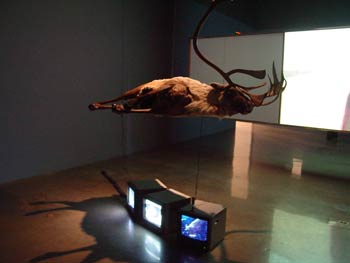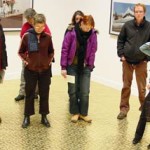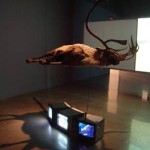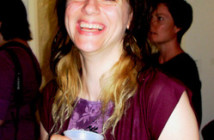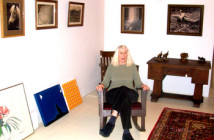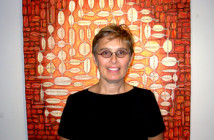When Jane Farver left the position of chief curator at the Queens Museum to become director of the MIT-List Visual Arts Center in 1999, I wrote a Perspective piece for Art New England. She has made good on many of the mandates she discussed back then particularly the ambition to improve on the aspects of education, public outreach, community involvement and strategies to make the museum more of a vital part of one of the world’s foremost research institutions. To reach that goal she has assembled a small but superb staff. In particular, Bill Arning has emerged as Boston’s most high profile and ubiquitous curator.
That creates a nice balance as Farver is less visible other than at List events. While she is maxed out in her commitment to making the List one of the finest university based, contemporary exhibition programs in the nation that keeps her ensconced in administrative responsibilities. She states that “I’m a bad Boston person. It feels like it’s home but I have another home.” Primarily because she has a tough weekly commute. She works at the List from Monday through Thursday evening when she drives to Queens. On Friday there are New York appointments with artists, board members, and other aspects of official List business. Saturdays are devoted to gallery and museum shows and on Sunday evening she returns to Boston. It’s a tough grind and administrators at MIT do not get the long summer vacations of academics.
We got together mid week for a beer and burger. It amazed me that it had been six years since we had a sit down so there was a lot of catching up to do. In addition to a full schedule of shows at the List some of them have traveled including major international projects. She recently completed a four day visit to Venice where she wrote the catalogue for the exhibition of work by Artur Zmijewski which was installed in the Polish pavilion of the Biennale. She was a part of a team of curators for a Whitney Biennial. The List organized the Fred Wilson show for the American Pavilion in Venice in 2003. She and Holly Block were commissioners for the American entry of the Cairo Biennial in 2003/ 04 featuring Paul Pfeiffer and that show traveled to the Olympics in Athens in 2004. A List organized Pfeiffer show traveled to the Chicago Museum of Contemporary Art and the Honolulu Contemporary Art Museum. A Michael Joo show traveled to the Palm Beach Institute of Contemporary Art. An upcoming Arning show on Kate Ericson and Mel Ziegler will travel to four museums.
In addition to organizing shows the List also takes traveling shows which fit its programming philosophy. It was actually an exchange of shows some time back which first brought Farver to the attention of the List and led to being asked to interview for the position.
Farver grew up in a small town and did not actually visit an art museum until she was 19. There is something of that rural, down to earth quality even now when she commands a position of influence in the field of contemporary art.
I asked to retrace the steps. Just how did she get from there to here? What are the makings of a top level contemporary curator and museum director? Today, there are a number of arts administration graduate programs but when Farver entered the field you had to invent yourself. It started with a master’s degree in art history from Kent State which did not offer courses in contemporary art. She groaned when I asked about her thesis topic. It was a catalogue of the Louis Comfort Tiffany windows in Cleveland.
Anxious to get into the field of contemporary art she ran an alternative program in Cleveland called “Spaces.” The job lasted 4-5 years and she remembers it fondly. “We chose artists and they could do what they wanted,” she said. “I was a fund raiser and administrator. We got the first block grant for an arts organization from the city. Eventually they moved into a warehouse in downtown Cleveland and bought their own facility. We got NEA money and did 13 shows a year as well as 50 performances. It was a very lively program.”
I asked what the Cleveland art scene was like. While she stated that there was good spirit and energy in order to sustain a viable arts community you need “Critical mass including museums, galleries, alternative spaces, collectors, art schools and critical writing.” Adding that a strong mix of those elements exists in only a few cities.
She took a position at the Alternative Museum as curator and assistant director. This brought her to New York and the mainstream of the art world where she has flourished ever since. She worked with director Geno Rodriguez on White Street in Tribeca for two and a half years. She took over the position vacated by Robert Browning when he left to found the World Music Institute. Prior to that the Alternative Museum was staging a concert each week which involved taking down and reinstalling shows. While at the Alternative museum she organized a show of the notoriously difficult and complex artist/ philosopher Adrian Piper which traveled for two years.
After the Alternative Museum there was an interval of two years with a small commercial gallery. It was enough to convince her to return to the non profit, alternative museum world. She moved on to the Bronx Gallery of Lehman College at CUNY. “I liked CUNY a lot,” she recalled. “The students were amazing. It represented for many of them their first and last opportunity to get an education. At graduation there was always an example of a former bus driver, for example, who became a Rhodes Scholar. It was about individuals who went to school against all odds.” But funding became a tough issue when Governor Mario Cuomo slashed budgets. While at CUNY she was asked to be guest curator of a show of Korean artists by Mo Bahc for the Queens Museum. He was working with Seoro (The Korean Contemporary Arts Network) and the exhibition was “Across the Pacific: Contemporary Korean and Korean American Artists.” The artist lived in New York from 1982 to 1995 when he returned to Korea. He died a year ago and Farver wrote a catalogue essay for an exhibition of his work at the University of California at Irvine. “I knew Mo when he worked as an installer at Lehman,” she said.
When a position opened up at the Queens Museum she was asked to apply. “I loved CUNY but there was the temptation to be back at a place where the first priority was art,” she said. “I was head of exhibitions for seven years.” She told me six years ago how the Queens Museum was an uniquely community involved institution. Part of that experience and orientation carried over when she was invited to apply for the List job.
“When I interviewed,” she recalled. “I was asked to describe my ideal audience member. I answered, ‘My mom.’ I always try to imagine how she would respond to an exhibition. Would she get it? My mom is very bright. So wall texts and brochures are very important. It is a priority that we are building an audience. As a part of that we send invitations to students. Toward that goal we hired Hiroko Kikuchi, an artist, who handles education and outreach.”
I asked just how one might identify a List exhibition or project under her watch. Given the limited resources of time, staff and budget how do you set priorities and divide the pie? How does the List fit into a rich and complex mix of a city and community with many and diverse arts institutions from the Museum of Fine Arts and the Institute of Contemporary Art, to the Fogg Art Museum, The Rose Art Museum, the DeCordova, Mass College of Art and the many smaller university and school programs as well as alternative spaces. Certainly the urban area has the critical mass of institutions that she describes as vital to a vibrant arts community. Within that broad range of institutions how does one design a program suitable to a university with global status and influence? These are tough questions to which she gave careful responses. In discussing her own program she did not want to make comments critical of other institutions.
That said, the List program is glaringly different. Where others appear to start with artists famous by art world consensus, offering us the already familiar, at the List we are conditioned to expect the unexpected. The shows entail a steep learning curve. But I have such enormous respect for the integrity of her curatorial vision that it is always a challenge to get up to speed with what is presented. Part of the fun is sending students to see the List shows and then grappling with their daunted responses. Particularly with students in my avant-garde class at BU. We have had some knock down drag outs over List shows. And when they ask me to explain the work I just bounce it back to them. It is not so much about knowing the answers, explaining the work, as the process by which we experience it. Jane responded that “we do not try to choose difficult exhibitions.” Rather, this is a byproduct of presenting the most important new work on a global level.
It is particularly ambitious to present shows like the Elaine Sturtevant traveling show last Spring that prove to be a tough sell to audiences. Viewers and even critics were much divided in their response to her work which involves “redoing” the works of others. Not that shows are about head counting but someone is keeping track. An academic program, such as the List, might be cut a bit more slack than the ICA or MFA which calculate the success or failure of programming by attendance. Shows such as Sturtevant are projects which most institutions would not risk presenting.
Perhaps it is best to think of the List as yet another MIT laboratory of the visual information of the moment. “We take a team approach,” she said. “When an exhibition is suggested we sit down with the staff and discuss the feasibility. Is there anyone doing the same or a similar project? Are we duplicating the efforts of others? Do we have the funds and resources to do the project? Who is the audience for that exhibition? How can we help the artist to reach an audience? If you look at the MIT campus all of the buildings are different unlike our neighbor Harvard. Because our architecture is of the time. Similarly we should have a museum of our time and not be a part of past oriented research. We are not just dealing with technology but the issues of our time. For example we have recently shown artists from Moldova and Poland. They grew up under socialism and matured under capitalism. That is very important and we got very strong responses from the audience that surprised me. There were a number of visitors who had contact with the Roma culture. Far more than I thought would be the case.”
Just how does she find such work to bring to the List? As a museum professional it informs how she looks at work. “You are always looking at new work from the point of view of how it fits in to your programming, how to present it,” she said. Has she ever done a popular, crowd pleasing show? She smiled and responded, “Yoko Ono. She was wonderful to work with and a lot of people came to that show. But that was not our motive. I don’t choose things because they are difficult. Take for example the Polish artist Artur Zmijewski. I first saw the work in Manifesta in 2002. We showed it and it is now in Venice. As a result of that I am getting calls from curators who want to know about the work. There are certain things that we do that eventually gain consensus, but I can’t say why.” Until you achieve that consensus, which may or may not happen, it’s about the challenge. But nobody promised that it would be easy.
- Farver leading a tour of Pavel Braila exhibition at the List.
- Installation shot from Michael Joo exhibition curated by Farver.
Links:
MIT List Visual Arts Center
All images are courtesy of Jane Farver and The List Visual Arts Center at MIT.

